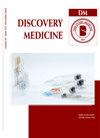AEBP1 Contributes to Breast Cancer Progression by Facilitating Cell Proliferation, Migration, Invasion, and Blocking Apoptosis.
IF 2.1
4区 医学
Q3 MEDICINE, RESEARCH & EXPERIMENTAL
引用次数: 1
Abstract
BACKGROUND The aberrant expression of adipocyte enhancer binding protein 1 (AEBP1) has been observed in many cancers and it seems to be involved in the tumorigenesis, progression, and metastasis in numerous tumor types. However, the contribution of AEBP1 in breast cancer (BCa) remains inexplicable. METHODS Information related to the diagnostic significance and expression of AEBP1 in BCa was obtained from the public dataset Kaplan-Meier Plotter (http://kmplot.com/analysis/) and the dataset UALCAN (https://ualcan.path.uab.edu/index.html). The MTT (methyl thiazolyl tetrazolium) assay, colony formation assay, Transwell® assay, and FACS (fluorescence-activated cell sorting) assay were used to detect the proliferation, invasive and apoptotic ability of cells before and after treatment. In addition, we constructed an AEBP1 overexpression vector and silenced AEBP1, combined with Real-Time Quantitative Reverse Transcription PCR (qRT-PCR), western blot, immunohistochemistry and TUNEL (terminal deoxynucleotidyl transferase-mediated dUTP-biotin nick end labeling) assay to investigate the prognostic significance, biological functions and potential mechanisms of AEBP1 in BCa. RESULTS Higher expression of AEBP1 mRNA (message RNA) was observed in BCa patients with later-stage, who obtained poorer overall survival. Meanwhile, compared with adjacent noncancerous tissues, AEBP1 protein expression was dramatically upregulated in the BCa ones. Furthermore, overexpressed AEBP1 enhanced cell proliferation, migration, invasion, and blocked cell apoptosis in BCa cells. Moreover, the research certificated that AEBP1 upregulated the expression of MMP (matrix metalloproteinase)-2, 9, vimentin, N-cadherin (neural-cadherin), phosphorylation of ERK (extracellular signal-regulated kinase), Smad2/3 (Abbreviated from Sma for nematode and Mad for Drosophila) and AKT (V-akt murine thymoma viral oncogene homolog), while down-regulated the expression of E-cadherin (epithelial cadherin) and PTEN (phosphatase and tensin homolog deleted on chromosome 10). To inhibit cell apoptosis, enforced expression of AEBP1 effectively blocked the cleavage of caspase 9 and p53 (protein 53) and promoted the expression of anti-apoptotic protein Bcl-2 (B-cell lymphoma-2). Finally, AEBP1 accelerated subcutaneously transplanted tumor growth in nude mice by increasing the expression of the cell proliferation biomarker ki67, the phosphorylation of AKT, and blocked apoptosis in vivo. CONCLUSIONS In summary, these data suggested the important role of AEBP1 in the BCa progression, which could be used as a potential biomarker for prognostic hallmark and a novel therapeutic strategy.AEBP1通过促进细胞增殖、迁移、侵袭和阻断凋亡参与乳腺癌进展。
背景:脂肪细胞增强子结合蛋白1 (AEBP1)的异常表达已经在许多癌症中被观察到,它似乎参与了许多肿瘤类型的发生、进展和转移。然而,AEBP1在乳腺癌(BCa)中的作用仍然无法解释。方法:从公共数据集Kaplan-Meier Plotter (http://kmplot.com/analysis/)和数据集UALCAN (https://ualcan.path.uab.edu/index.html)中获取与AEBP1在BCa中的诊断意义和表达相关的信息。采用MTT (methyl thiazolyl tetrazolium)法、菌落形成法、Transwell®法和FACS (fluorescence-activated cell sorting)法检测治疗前后细胞的增殖、侵袭和凋亡能力。此外,我们构建AEBP1过表达载体并沉默AEBP1,结合实时定量反转录PCR (qRT-PCR)、western blot、免疫组织化学和TUNEL(末端脱氧核苷酸转移酶介导的dutp -生物素缺口末端标记)检测,探讨AEBP1在BCa中的预后意义、生物学功能和潜在机制。结果:AEBP1 mRNA (message RNA)在BCa晚期患者中表达较高,总生存期较差。同时,与癌旁非癌组织相比,BCa组织中AEBP1蛋白表达显著上调。此外,过表达的AEBP1增强了BCa细胞的增殖、迁移、侵袭,并阻断了细胞凋亡。此外,研究证实,AEBP1上调MMP (matrix metalloproteinase)- 2,9、vimentin、N-cadherin (neurocadherin)的表达,上调ERK(胞外信号调节激酶)、Smad2/3(线虫缩写为Sma,果蝇缩写为Mad)和AKT(小鼠胸腺瘤病毒癌基因同源物)的磷酸化,下调E-cadherin(上皮性cadherin)和PTEN(10号染色体上缺失的磷酸酶和紧张素同源物)的表达。为了抑制细胞凋亡,强化AEBP1的表达可以有效阻断caspase 9和p53(蛋白53)的裂解,促进抗凋亡蛋白Bcl-2 (b细胞淋巴瘤-2)的表达。最后,AEBP1通过增加细胞增殖生物标志物ki67的表达和AKT的磷酸化,促进裸鼠皮下移植瘤的生长,并在体内阻断细胞凋亡。结论:综上所述,这些数据表明AEBP1在BCa进展中的重要作用,可以作为预后标志的潜在生物标志物和新的治疗策略。
本文章由计算机程序翻译,如有差异,请以英文原文为准。
求助全文
约1分钟内获得全文
求助全文
来源期刊

Discovery medicine
MEDICINE, RESEARCH & EXPERIMENTAL-
CiteScore
5.40
自引率
0.00%
发文量
80
审稿时长
6-12 weeks
期刊介绍:
Discovery Medicine publishes novel, provocative ideas and research findings that challenge conventional notions about disease mechanisms, diagnosis, treatment, or any of the life sciences subjects. It publishes cutting-edge, reliable, and authoritative information in all branches of life sciences but primarily in the following areas: Novel therapies and diagnostics (approved or experimental); innovative ideas, research technologies, and translational research that will give rise to the next generation of new drugs and therapies; breakthrough understanding of mechanism of disease, biology, and physiology; and commercialization of biomedical discoveries pertaining to the development of new drugs, therapies, medical devices, and research technology.
 求助内容:
求助内容: 应助结果提醒方式:
应助结果提醒方式:


